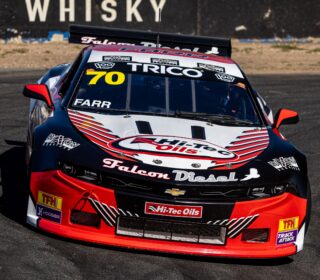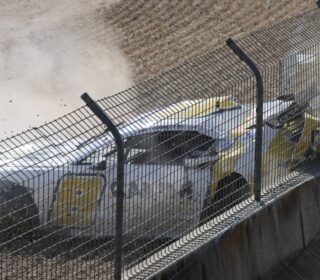MERCHANDISE: THE SUPERCARS MONEY MACHINE
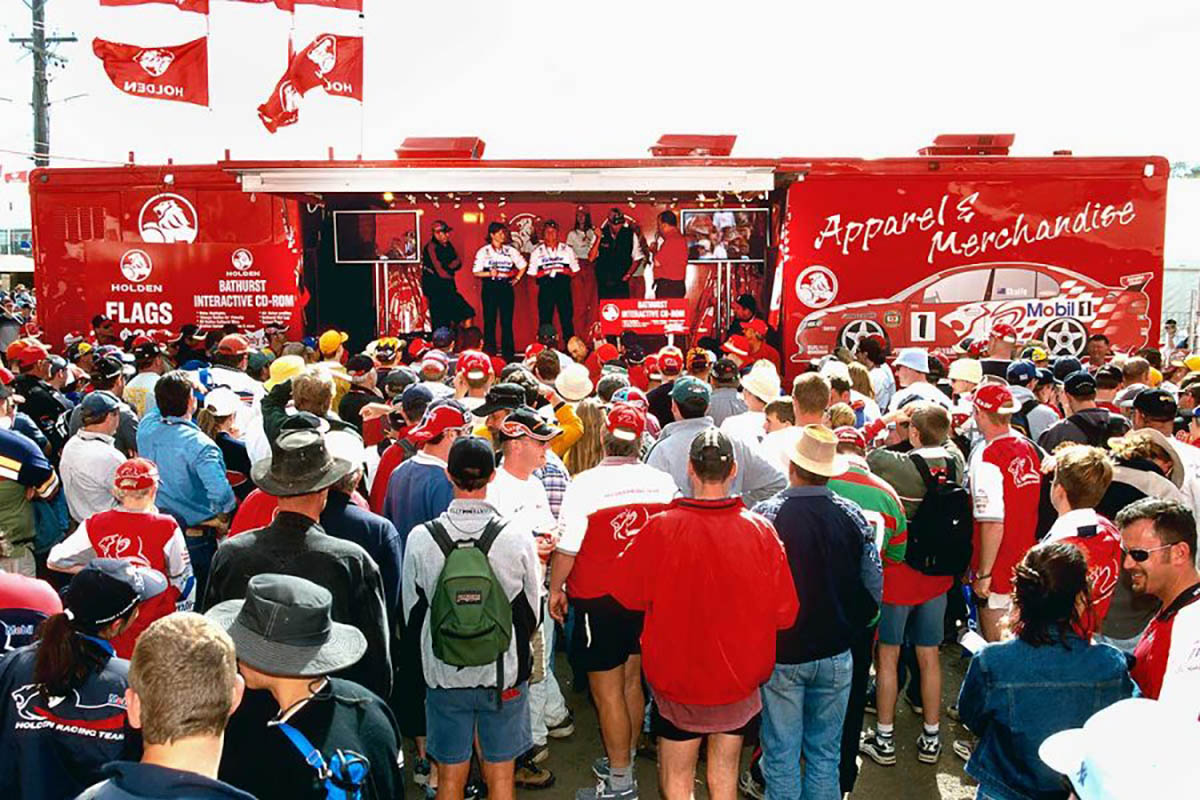
FROM selling T-Shirts on a trestle table outside the garage to impressive shopping-centre experiences in the paddock area, the art of selling Motorsport Merchandise to fans has evolved significantly – and contributed millions to the bottom line of brands – over the years, as DALE RODGERS investigates.
WORDS: Dale Rodgers
IMAGES: AN1 Images, Mark Walker, John Crennan Collection, Dale Rodgers
Wander through any airport or shopping centre in Australia and odds are you will see a Supercars Team Jacket, a Cap or T-Shirt from a Holden or Ford team adorning a fan. It may be a current Red Bull Holden piece or an old HRT or even DJR design, but rest assured it won’t take long to find one.
Only the AFL can boast a merchandise program that comes anywhere near Supercars and even then, it is so tightly controlled by the League, that the clubs have little leeway on design.
Supercars Teams Merchandise programs is big business. There was a time that only the well-heeled and commercially savvy teams served up a range, and relatively basic at that, however now, a fan can purchase an item from just about every team and driver combination on the Supercars grid. Products extend through full ranges of apparel including shirts, jackets, beanies and even undies, flags, and key rings, die-cast models, backpacks, even soft toys and umbrellas.. a must at rounds like Symmons Plains and Winton!
But it wasn’t always that way. The explosion in the then V8 Supercars Merchandise programs is largely credited to John Crennan, the boss of the all-conquering Holden Racing Team and parent HSV. Crennan and his team saw a major opportunity in the mid 1990’s and developed the program. It struck gold in 1997 when the V8 Supercars Championship hosted the Peter Brock Farwell Tour.
The circuits were packed with spectators who were intent on getting an HRT cap, T-shirt or jacket signed by Brock, and the cash registers in the HRT Merchandise area did not stop ringing.

On the ‘Blue’ side of the pits, it was Dick Johnson who was developing and promoting a range of Shell-branded DJR merchandise around the same time, and although successful was not in the same league as the HRT range and popularity.
“The first dabble was in 1988 or 89 when Marg (Crennan’s long time Exec PA, Marg Curtis) and I decided to get a couple of grand of T- Shirts and Caps made and put them on a trestle table out side the garage at Bathurst and see how we go,” Crennan recalled.
“We put them out on Thursday afternoon around 2.00pm and they were all gone on Friday morning! For the rest of the weekend people were running around and asking, ‘where can we get them?’ ” he recalls.
The program was built gradually and run in house right up to the time of Crennan’s departure from the company in 2007.
“The advent of Brock probably catapulted it forward another three times in 1994,” Crennan said.
“Everything has to be right for it to hit the market and be successful. We thought Wayne Gardner (who drove for HRT in 1993) would be pretty solid in merchandise but it was nothing. Despite all his international success it came to nothing with the fan base when he joined us in ‘93. That just didn’t sell. Then we had Brock from 1994 and it went mad. It just built and built every year.”
Although the growth of the Merchandise Sales for HRT grew throughout the then-named ATCC, it was Bathurst where the focus to maximise the income was focused. Stocking was critical and the the trestle table made way for larger and more expansive selling areas.
“We would have the numbers right for Bathurst, the Thursday, Friday, Saturday and Sunday and I would be walking out and heading to the bank with bag loads of cash.. Up to $250,000 in cash by 3.00pm on a Friday!” Crennan said.

HRT went from strength to strength with its merchandising and product program, and after the Brock era, Craig Lowndes became the crowd favourite and a new wave of fans and merchandise sales ensued. However, unlike many who simply produce product and hope it sells, Crennan and his team were identifying and developing new channels of distribution and fine tuning product continually. The team pioneered the range of female apparel and gear after research clearly showed that a large portion of the fan base were not men. So too the distribution channels, that were far more strategic than just race track sales.
“When I look back on business, I say there are really only two things that matter. The product and the distribution,” Crennan suggests.
“The product was spot on, we had massive coverage and in the end we had distributors in every state. The Holden HSV Dealers bought off the state distributors, we really worked motor shows, we really worked truck shows, and on top of that we turned up to major events and of course had a huge presence at the race track.”
Despite GMH often telling Crennan and his HSV Team that they were spending far too much time on the merchandise and apparel program and not on selling cars, John had a totally different vision.
“It was so important selling a $20 T Shirt or cap to a fan as you were constantly developing brand aspirants. We were just gathering new customers all the time,” was Crennan’s response to that criticism.
“My theory was that the T Shirt or the Cap took the place of the poster. The poster ended up on the bedroom wall and the only people who saw it were your mates that came around. The T-shirt was worn (outside) and so many people liked to imagine they were part of a team.
“We were winning Championships. Our drivers – The Lowndes, the Skaife’s and the Brock’s were high powered role models. I say this advisedly but Jamie Whincup is a phenomenal Champion, but he is vanilla. We had the benefit of guys (drivers) who were out there, they were energetic and they related brilliantly to the public. All these things helped our business markedly,”
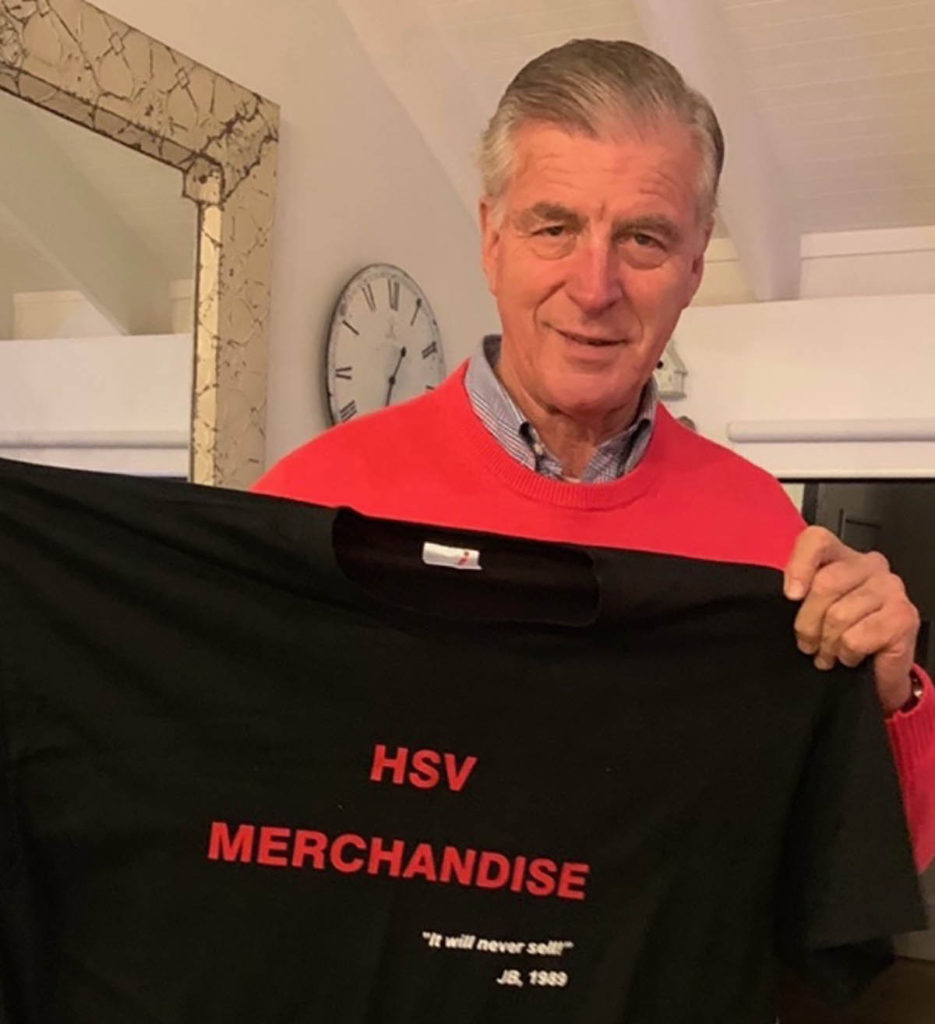
The income level for HRT was $13.5 million: made up of $8 million in sponsorship, $2 million in prize money, and the rest coming from the net profit of merchandise..
– John Crennan
“It became the engine room of our business. On a Monday morning everyone would want to know how we went at Amaroo, how many shirts and caps did we sell,” he said.
“The other marvellous thing about it being all in house was we would send about fifteen people to Bathurst to man the stall. We recruited people out of of the finance department, out of the engineering and manufacturing departments. People we thought had a good customer approach, and it was allowed them to meet the customers. And they learned so much from the experience.”
In speaking about the actual mechanics of a large scale operation, Crennan fiercely protected the program being a full in house operation, something that is not seen at all in today’s merchandising environment.
“There was nothing wrong with buying a cap for $5 and selling it for $20,” Crennan said.
“I just don’t get the change over the last fifteen years where teams now appoint someone to do it, and they sell a $20 cap on your behalf and give you a 15% royalty. I far preferred to make $15 on a cap than $3!”
The power of the total HRT / HSV merchandise program was put into focus as Crennan outlined that in 2002, before the dilemmas overseas with the parent TWR, the income level for HRT was $13.5 million: made up of $8 million in sponsorship, $2 million in prize money, and the rest coming from the net profit of merchandise.
But times change and just as John Crennan said that he would keep these programs in-house even today, the market is now dominated by licensing and merchandise companies offering teams a start to finish program including elaborate on track superstores.
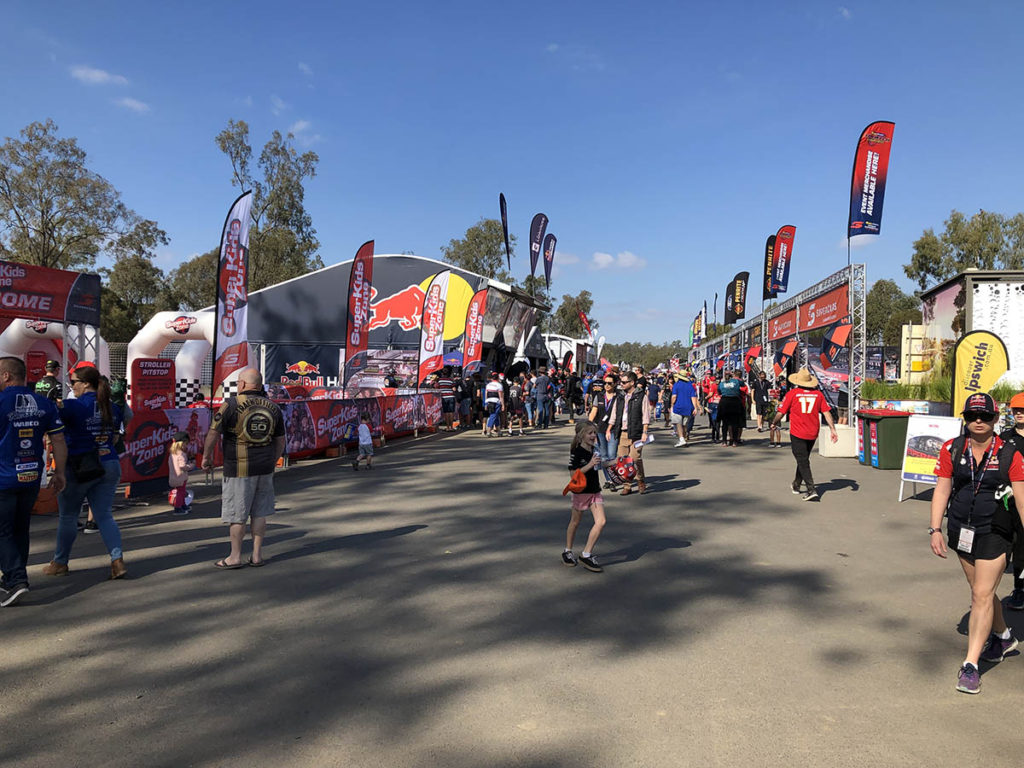
The leader in this field is TPF Sports. Although the company was well established in Olympic and the two main Football codes in Australia, Motorsports and in particular Supercars did not come on the radar until 2014 when they were appointed the brand and licensing agency for Holden, HRT, HSV and Red Bull Racing.
TPF Sports Motor Sport General Manager, Peter Nicoll takes up the story.
“The offer of working with Holden was presented to us back in late 2014. This was to become Holden’s master licensor and this also entailed the Supercars Teams of Triple Eight, now Red Bull Racing and Walkinshaw’s Holden Racing Team. Using our credentials of what we had done in the past in other categories and sports, we bought that into the motor sport world,” he said
As the market continued to evolve, the strategy was to offer a not only a range of retail products to race fans, but to develop a full on track store environment: A long way from the tents and transporters that had been the norm to that point.
“We called it the David Jones or Myer on track experience and really raised the bar of what the whole customer experience was like at the track,” Nicoll added.
Like many companies from outside motor sport who become involved with Supercars, the fan base is always noted for its uniqueness and tribalism.
“One of the things I noticed after spending more time on track in the early years was just how passionate these fans are and how they wear their team colours with pride. They also wanted to come in and spend time in the stores (on track). In this environment, fans have got time to dwell, time to think, and time to chat. What works well with our execution is the staff on the floor who engage with the fans, talk to them about their team, talk to them about their interest buy some merchandise or even wander off an often come back during a break in the program and purchase then,” he said.
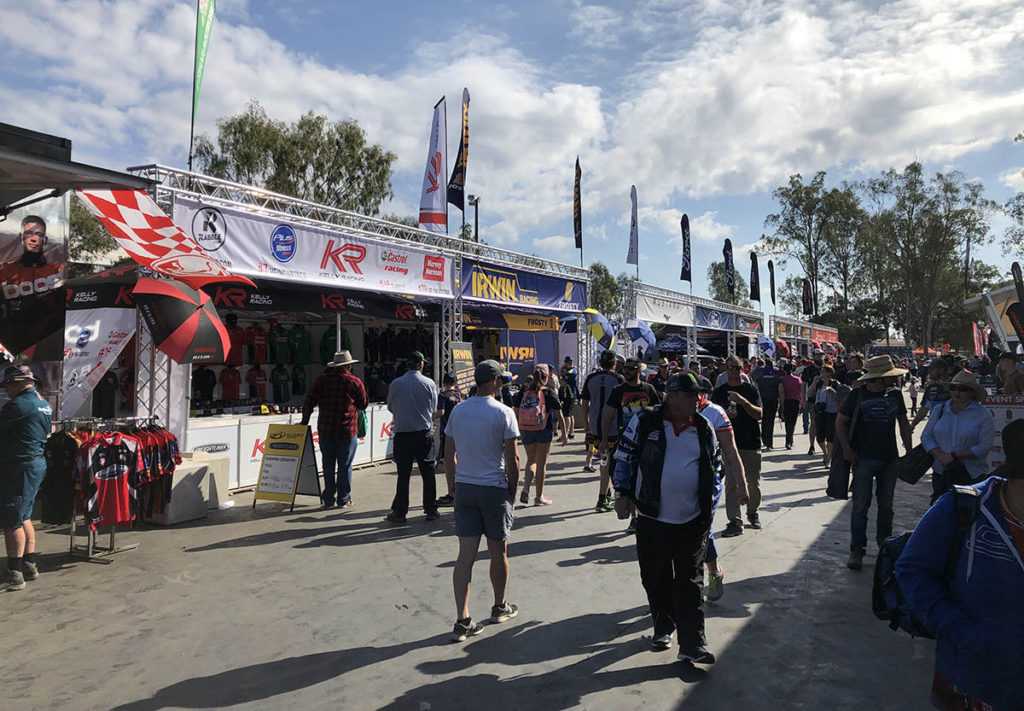
One of the visual differences in recent times has been the explosion of ‘superstore’ merchandising concepts at race tracks. These bespoke structures would not look out of place in shopping precincts with raised floors, striking graphics and merchandise on modern retail racks rather than in plastic bags and boxes behind a counter.
“We represent the teams and we represent the brands so we want to make sure the fans get a really good experience. We invest a lot of time and money in the (superstore) format. We have our skin in the game and we get a lot of support from the teams through driver signings and on track activation with the team’s partner’s ads to the theatre and the excitement,” Nicoll said.
“We wanted to build a destination where fans could come and spend time in.”
In 2020, the landscape has changed dramatically for Supercars teams who were looking forward to solid revenue from Merchandise programs. Sales were no doubt buoyed at the Adelaide 500 then slammed shut as COVID-19 shut down the sport until its resumption in June. Only recently have teams been able to sell limited stock on track as spectators returned to Darwin, Townsville and The Bend. Discounted gear now appears on most team websites, social media posts and advertising.
It is big business and a key success factor in the overall health of every Supercars team, no matter where they sit on the grid.




